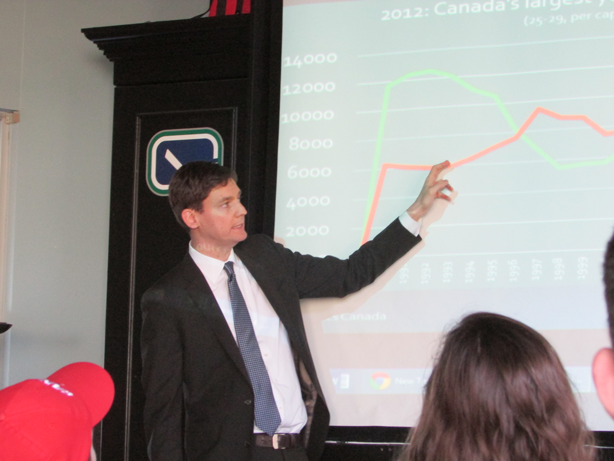Print Edition: February 5, 2014

The latest forecast from opposition critic for advanced education David Eby shows little new hope for students.
“B.C. students can’t afford our own education system anymore,” Eby told a small crowd in UFV’s dimly lit campus lounge on January 31.
Shortly after 11 a.m., a mix of students and graduates gathered in AfterMath to hear Eby’s evaluation of B.C.’s educational climate and to share their own experiences funding their degrees. Visiting a number of the province’s publicly funded post-secondary institutions, Eby hopes to bring his findings and students’ stories to the legislature in Victoria in February.
He explained one of his early stops at Thompson Rivers University during a student orientation day revealed a sobering reality. He spoke with 15 students in line before he met one from B.C. It raised an important question. Why were there so few B.C. students there?
“I started looking for real-world impacts we can see as a result of the failure of the student loan system in B.C.,” he said.
One of the first things he found was that B.C. residents are least likely in Canada to pursue full-time studies. In actuality, B.C. residents were more likely to enroll in part-time studies and programs, despite the fact that the student loan program does not cater to those students.
He also pointed out that government-held student debt is on the rise, and asked rhetorically how such an increase is possible when B.C. lends the least amount in student loans in the country. It boils down to interest.
“B.C. and New Brunswick both charge prime plus two per cent,” he explained, noting the extra two per cent on top of what it costs the government to loan the money in the first place generates $36 million per year for the provincial government.
[pullquote]“The government has actually imposed a two per cent tax on the people who need to borrow the most.”[/pullquote]
“The government has actually imposed a two per cent tax on the people who need to borrow the most,” Eby concluded.
Another trend he noticed on his university visits is something he never encountered when he attended school more than a decade ago: student food banks. These have become a necessary resource for students struggling to study and eat; UFV’s Student Union Society implemented one on the Abbotsford campus in October.
Eby also raised the issue of youth unemployment in B.C., citing that the province dropped to last place with the highest rate in 2012. They were in second place six years before that.
In 2012, one in 10 residents aged 15 to 19 was not working or in school; one in seven 20- to 24-year-olds and a startling one in five 25- to 29-year-olds were in the same situation.
“How do you correlate the fact that we have the most people not in school, not in work, and not in training with the fact that we have the lowest participation rate for full-time studies in Canada?” he asked.
One of the ways these figures manifest themselves is in social assistance. The largest increase in new welfare recipients is in residents aged 55 to 64, who Eby explained would have the most difficulty reentering the economy after losing their jobs in an economic downturn, and would benefit most from part-time training programs.
“The second highest increase in welfare cases in B.C. is among 19- to 24-year-olds, and this is the cohort that presumably would be most likely to go to school rather than receive welfare,” he said. “For some reason in B.C. that’s not happening, and there’s a massive spike in social assistance cases among that group.”
The other consequence of low access to education is migration. Eby presented a graph of net migration in and out of the province, which showed B.C. losing people of prime working age. 2012 was the highest point in youth migration out of the country since 1990. Meanwhile, people at or nearing retirement age were migrating into B.C.
“If this trend continues, B.C. will be a wonderful retirement community, but we’re really undermining the future of the province in terms of economic development,” he said.
Of course, Eby admitted to his audience, largely comprised of students, that he was preaching to the choir, but said he hopes to get feedback on whether students agree with his assessment, and wants to hear their experiences.
“It’s pretty dark right now for young people in British Columbia,” he determined, then opened up the floor for students to weigh in.

